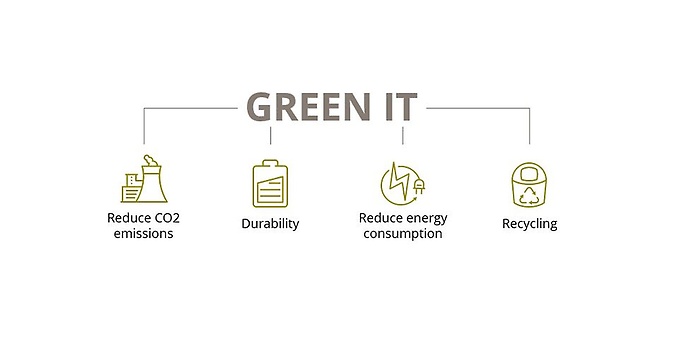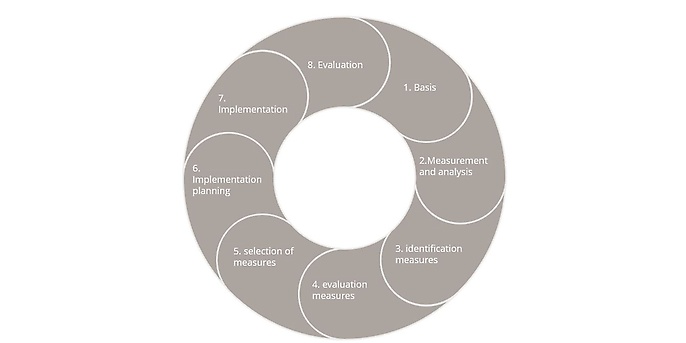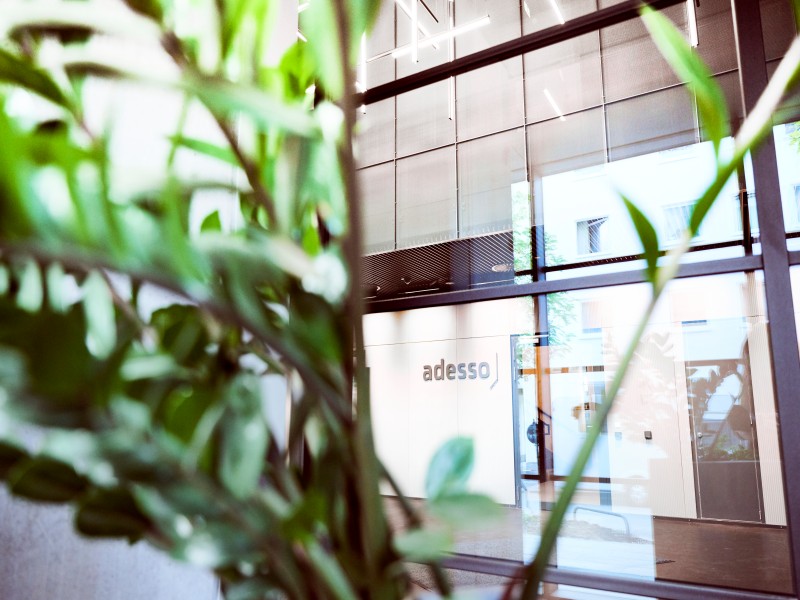24. March 2023 By Lynn Nguyen
Green IT: sustainability for the public sector
Green IT is no longer a new trend and many people are already familiar with it, but what exactly does it mean? The definition of the German Federal Ministry for the Environment, Nature Conservation, Nuclear Safety and Consumer Protection (Bundesministerium für Umwelt, Naturschutz, nukleare Sicherheit und Verbraucherschutz, BMUV) divides green IT into two groups:
The first group is environmentally friendly IT products and IT services. This includes hardware, software, digital services such as streaming, but also data centres. The entire life cycle of IT products and their environmental impact are considered in the process.
The second group describes the use of IT for environmental protection. The overarching goal of Germany’s Green IT Initiative is to increase environmental and social sustainability as it relates to information technology, for example, by reducing CO2 emissions in the manufacturing process and during use and by conserving and reusing resources.

The public sector as a regulator
The first attempts at setting up green IT can be found back in 1992 in the form of the Energy Star label introduced by the US government for energy-efficient hardware. More than 30 years later, many companies already consider sustainability to be an important part of their corporate strategy for the future and see it as a crucial success factor, while other companies still need mandatory requirements in order to implement appropriate measures. For this reason, the German government has created corresponding laws. For example, the German Supply Chain Act, which came into force on 1 January 2023, requires large companies to take responsibility for respecting human rights and environmental protection throughout the supply chain. In addition, the Federal Ministry for Economic Affairs and Climate Action (Bundesministerium für Wirtschaft und Klimaschutz, BMWK) presented a draft law in October 2022 that is intended to significantly tighten the regulations for data centres with regard to energy efficiency; this is still being voted on (as of March 2023). But what about the public sector itself in terms of sustainability and the implementation of measures in this sector? How does the public sector, which is not subject to the typical rules of the private sector, design its processes and structures to be as sustainable as possible?
The German government’s voluntary commitment regarding sustainability
The German government published its first sustainability strategy back in 2002. Since then, it has been continuously updated and since 2016 has been oriented towards the 17 Sustainability Goals of the UN.
The topic of green IT is also becoming increasingly relevant in the public sector.
Most countries have developed their own sustainability strategies in this regard and sustainability measures are also being taken at national level. This is no coincidence, as the German government has set itself ambitious goals in the fight against climate change: the Climate Protection Act makes provisions for achieving greenhouse gas neutrality in Germany by 2045. The federal administration should explicitly take on a leadership role and be climate-neutral by 2030. To achieve this goal, it will be impossible to not have established a nationwide sustainable IT landscape and the necessary green IT measures. The German government has committed itself to acting sustainably through numerous policies.
For example, the German General Administrative Regulation on the Procurement of Climate-friendly Services (Allgemeine Verwaltungsvorschrift zur Beschaffung klimafreundlicher Leistungen, AVV Klima) prescribes specific energy efficiency and environmental criteria for procurement by federal authorities. The coalition agreement from 2021 also adopted the requirement to take sustainability criteria into consideration in procurement choices. Both the German Resource Efficiency Programme III and the Climate Action Programme also set the goal that the German government’s data centres should be operated in a more environmentally friendly manner and comply with the Blue Angel criteria for data centres. The IT Planning Council, which is the steering committee for the digitalisation of the administration in terms of policies and strategies, confirmed this again with the resolution [2022/05] in September 2022. The federal administration has already taken a number of steps and set up corresponding posts in order to implement the concrete objectives in the complex administrative landscape. In this manner, the Green IT Initiative of the German government, which is spearheaded by the BMUV, was founded in 2008, with the aim of making the IT at national level more sustainable and reducing the energy consumption of the federal administration.
The initiative has been a great success so far. Since its inception, the energy consumption of IT at national level has been reduced by 48 per cent (as of February 2023). Furthermore, a Competence Centre for Sustainable Procurement was created in the Procurement Office of the Federal Ministry of the Interior and Community (Bundesministerium des Innern und für Heimat, BMI), which offers advice and training for the approximately 30,000 procurement offices at federal, state and local level, in 2011. The Coordination Office for a Climate-neutral Federal Administration in the Ministry of Economics and Climate Action is responsible for drawing up a programme of measures with concrete and necessary measures to achieve greenhouse gas neutrality in the federal administration. It becomes clear that the German government is on the right track with regard to its own sustainability goals, but there is still some way to go. Green IT measures are certainly a great challenge, but the project also offers enormous opportunities. These are examined in more detail below.
The public sector as a lever on the market
There are even more far-reaching advantages, in addition to obvious benefits such as cost reduction through less energy consumption and savings of resources, as well as the protection of employees through low-emission procurement. The annual purchasing volume of the German government, the federal states and local authorities for IT products and services amounted to more than €20 billion in 2014 alone – about one fifth of the IT market in Germany. This clearly shows that the public sector is an influential customer that could push the market towards more sustainability. For example, tenders for hardware could stipulate even stricter social and environmental sustainability criteria, which might encourage companies to manufacture and offer their products and services accordingly. This includes aspects such as energy efficiency, materials, packaging or repairability or maintainability. In addition to procuring environmentally friendly products, the public sector could also change the market for data centres. As digitalisation makes greater advances, more and more computing power is required, and with it the need for electricity and resources. In turn, the environmental impact is enormous. According to the Borderstep Institute, data centres in Germany consumed 16 billion kilowatt hours in 2020 alone. This corresponds to more than 2.7 million metric tons in CO2 emissions – the equivalent of more than 500,000 long-haul flights. The federal administration has a tremendous need for servers. In 2021, it used approximately 190 data centres with a total energy consumption of more than 184 million kilowatt hours (equivalent to the CO2 emissions of nearly 6,000 long-haul flights) per year, and as a customer it could influence aspects of sustainability in the operation of data centres by taking factors such as energy efficiency, waste heat utilisation and utilisation of servers into account when selecting or operating them itself.
The federal administration could also achieve a lot in the area of software. For example, it could develop software with a low ecological footprint itself and implement it widely or take corresponding criteria into account in tenders. Sustainable IT services (such as web conferencing tools) also offer enormous potential for energy and in turn, cost reductions with regard to the high number of public sector employees and the increase in remote collaboration.
Sustainability also brings challenges
New, energy-intensive technologies, constantly growing amounts of data and regulation in general make planning in relation to information technology a complicated issue anyway. However, the public sector faces particular challenges, as it is known that it cannot act as flexibly as private sector companies and also often has to struggle with budget cuts.
In addition, the introduction of green IT measures is associated with a great deal of effort, as the status quo of the IT needs to be determined first in order to create a reliable baseline for further analyses and the derivation of measures.

Source: Zarnekow & Kolbe (2013)
This means for the public sector that they need to get an overview of around five million employees and their devices. In addition, data on structural factors such as the energy efficiency of buildings must be collected and the energy consumption of devices as well as data centres must be determined. However, to do so, the necessary infrastructure with appropriate measuring devices and monitoring tools must first be created. Unfortunately, a successful survey is only half the battle. Measures and potential savings must be identified on the basis of the data, but this is not always straightforward, as often only summarised metrics are available. The public sector has to manage all these steps at the same time as other, large and constantly changing projects, such as the IT consolidation at national level. In addition, there is often a lack of human resources, meaning that employees often have neither the time nor the corresponding expertise to understand and implement green IT measures in the required depth. There is a lack of competence centres that can convey interest and understanding across departments in order to awaken intrinsic motivation among employees, in addition to appropriate budgets for sustainability issues.
Conclusion
It turns out that the purchasing decisions of the German government, local authorities and federal states have a significant impact on the market and the environment. The public sector could save considerable costs on the one hand, but also live up to its leadership role through strategic decisions regarding sustainability. It is indispensable for achieving a climate-neutral public sector to make quick and qualified decisions and to implement the resulting measures. This is the only way to create the basic conditions for technological progress in harmony with the environment. It will most likely have irreversible damage for the environment as well as for credibility if the German government fails to create these structures. It is important to live up to the responsibility of being a role model for companies and civil society and to show that the issue of sustainability is a high priority in the public sector.
You will find more exciting topics from the adesso world in our latest blog posts. You can find out more about green IT at adesso on our website.
Also interesting:

